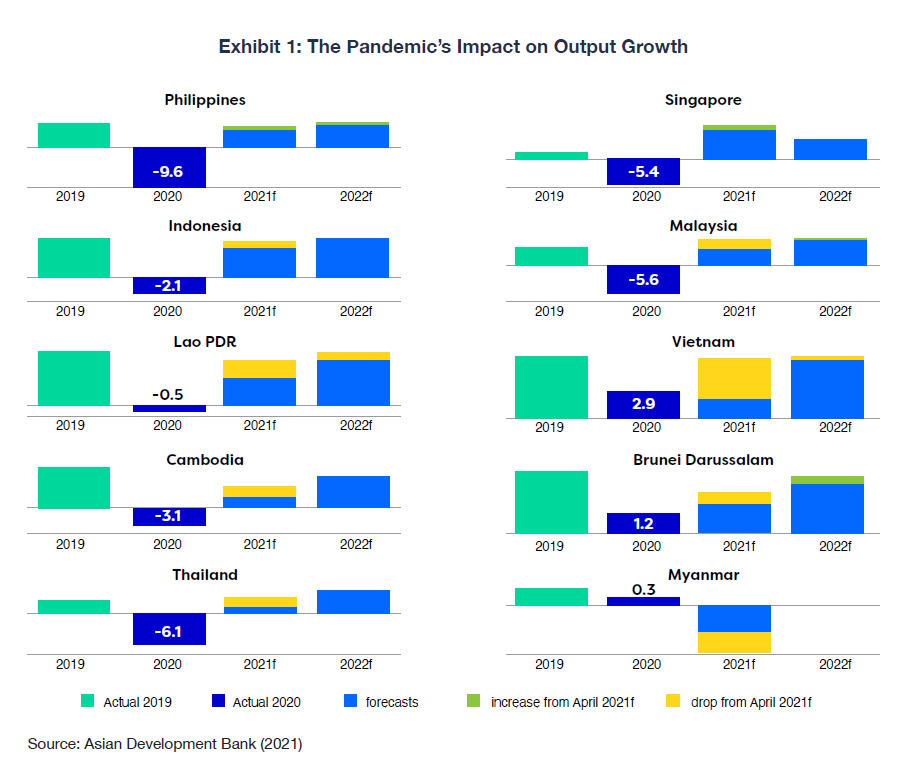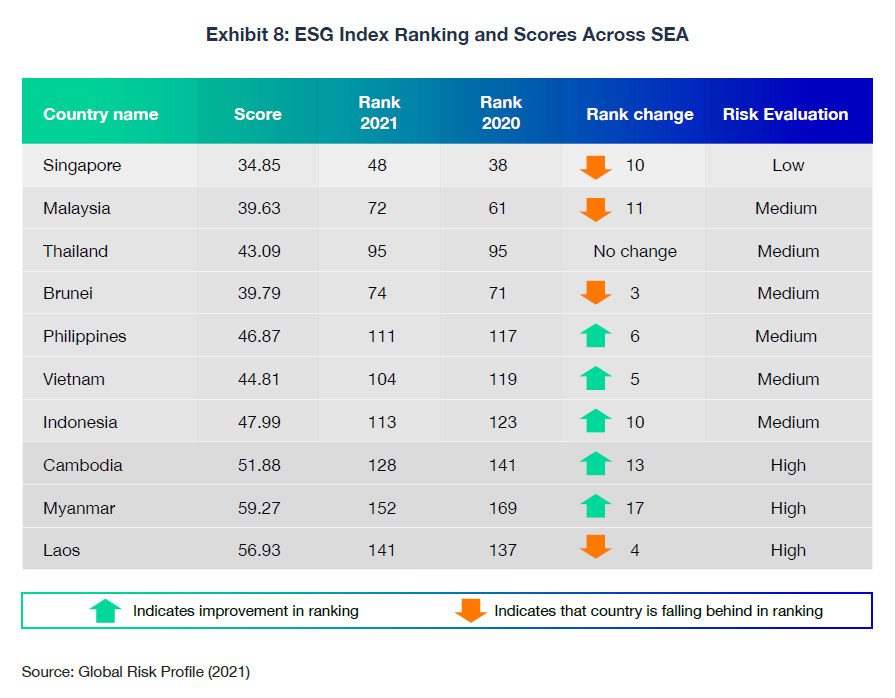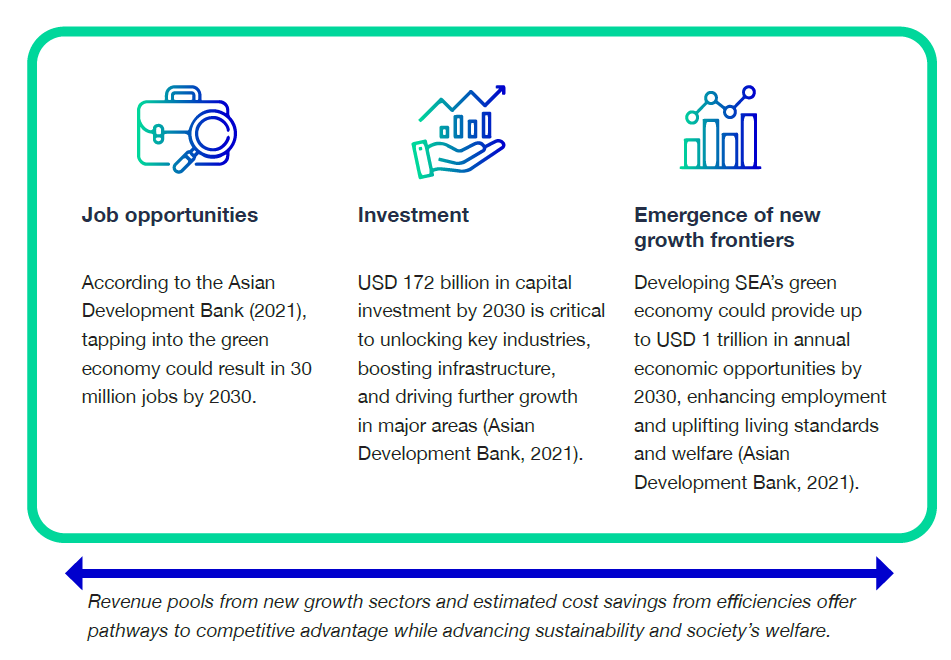Due largely to the onset of the COVID-19 pandemic, there has been a growing emphasis within Southeast Asia (SEA) to accelerate sustainable recovery. Such a development encompasses environmental, social, and governance (ESG) initiatives, policy-making conducive to sustainable growth, and public-private cooperation. As such, there is a growing expectation for corporates and governments to prioritize widespread, regional sustainable recovery in SEA.
To better understand current sustainability efforts in the region, potential opportunities and challenges, and the future outlook of sustainable development, read this excerpt from our latest white paper, Accelerating Sustainable Recovery in Southeast Asia, which you can read in full here.
The Significance of Sustainable Recovery in Southeast Asia (SEA)
With the effects of COVID-19, economies worldwide, including in the SEA region, will need to ramp up efforts to prepare for climate change, whose impacts are expected to be stronger and long-lasting on the global economy. SEA is particularly vulnerable to the climate crisis, with its exposure to different risks. Stakeholders show increased interest in sustainability and hold public and private entities accountable. The COVID-19 pandemic only further exposed and exacerbated SEA’s risks and vulnerabilities.

- The International Labor Organization (ILO) estimates that employment was 10.6 million less than during the pre-pandemic period in 2020. Unemployment was specifically rampant among women, youth, and workers in micro, small, and medium enterprises (MSME).
- According to the Asian Development Bank (2022), the number of people who are greatly destitute—defined as living on less than USD 1.90 per day—increased by 5.4 million in SEA in 2020 due to the extreme decline in economic activity. Moreover, in 2021, 4.7 million more people fell below the extreme poverty threshold compared to pre-pandemic levels in 2020.
The effects of the COVID-19 pandemic are expected to exist for a considerably long time. For the SEA region, the average output and anticipated output level in 2021 and 2022, respectively, are at least 10% below the simulated output level without COVID-19. Economies will need to ramp up efforts to prepare for the impact of climate change, which will represent an even more impactful and long-lasting externality to the global economy.
A Sustainable Recovery Driven by National and Regional Initiatives
The COVID-19 pandemic has spurred countries in SEA to take action in alignment with sustainable recovery. Several initiatives have been implemented during the pandemic, with the rolling out of stimulus packages, as well as fiscal and monetary policies, being the immediate initiatives aimed at driving sustainable recovery in the short term.
As the region progresses in addressing the impact wrought by the pandemic, it focuses its efforts on a national and regional level in several key areas, namely: corporate sustainability reporting, carbon tax and carbon credit market, energy transition and energy security, and sustainable finance. These initiatives signify the commitment of the region’s public sector stakeholders to prioritising sustainable growth.
Key Types of National and Regional Initiatives – COVID-19 has proven that most economies worldwide lack resilience when encountering externalities that have widespread consequences. Hence, there is a need for nations around the world to prioritize sustainable growth as part of policymaking to tackle climate change. In SEA, relevant public sector stakeholders have successfully implemented or planned various national and regional level initiatives to drive sustainable growth.
During the pandemic, the rolling out of stimulus packages and fiscal and monetary policies acted as immediate short-term initiatives to drive sustainable recovery. However, as sustainability remains a key focus moving forward, SEA countries have collectively adopted the ASEAN Comprehensive Recovery Framework in 2021, which details its efforts to recover sustainably from the COVID-19 pandemic and emphasizes the incorporation of green measures in its recovery initiatives. The key focus areas to drive a sustainable recovery include corporate sustainability reporting, carbon tax and carbon credit market, energy transition and security, and sustainable finance.

Key Sustainability Gaps and Challenges in SEA
While SEA is an economic powerhouse –with the combined GDP of member states making it the fifth-largest economy globally (Khan and Majeed, 2020) that offers tremendous growth potential—the region has been relatively slow to act with effective collective action. SEA is confronted by large and interlinked economic, social, and environmental challenges, as well as inefficiencies related to coordination among governments, and a lack of alignment across countries in the region.
Current Sustainability Gaps in SEA – Despite the conscious efforts made by the relevant public sector stakeholders in SEA, the path to long-term sustainable recovery will require consistent efforts as the countries in SEA face the need to balance their commitment to sustainability and high expected economic growth. This was evidently witnessed during the start of the pandemic whereby the region faltered in its environmental commitments as it mostly launched short-term fiscal and monetary initiatives to alleviate the immediate effects of the pandemic (Fulcrum, 2022). Hence, gaps in terms of sustainability-related indicators are expected due to the region’s complex situation.
SEA Overall Sustainability Performance | ESG – Global Risk Profile (2021) provides the ESG Index, which measures risks related to the environment, human rights, and health and safety. Country results are reflected on a 0-100 scale, wherein a score of 0 corresponds to the lowest risk, and 100 corresponds to the highest risk. Singapore is the only SEA country with a low ESG risk, while most countries remain at medium to high risk. However, it is noteworthy that half of the Southeast Asian countries are improving in terms of their ranking across the ESG index, particularly countries at high risk, such as Cambodia and Myanmar.

The Future Outlook of Sustainability Efforts
Sustainable recovery for SEA will result in various economic benefits, including increased job opportunities, investment, and the emergence of new growth frontiers. There are key green growth areas that the region’s public and private sectors should focus on—tapping into these green growth areas will have profound impacts on the overall development of SEA, and the well-being of its inhabitants. These areas include job opportunities, investment, and the emergence of new growth frontiers, which are interlinked and have carry-over effects on each other. Hence, relevant stakeholders from the public and private sectors in SEA should recognize and unlock these growth opportunities in tandem with one another.
Tapping into these green growth areas will profoundly impact the overall development of SEA and the well-being of its inhabitants. Beyond that, it will also have major effects on fast-tracking SEA’s potential to achieve the SDGs by 2030. To do so, SEA countries can leverage the following existing advantages present in the region: (1) robust innovation, (2) existing regional cooperation frameworks, (3) rising corporate awareness on disclosure and risk mitigation, (4) a shift towards sustainable mindsets, (5) investor enthusiasm for ESG, (6) rising digitalization and technological advancements, and (7) national initiatives.
To get further insight into emerging trends in several industries relevant in Asia and across the globe, subscribe to our newsletter here and check out these reports:





